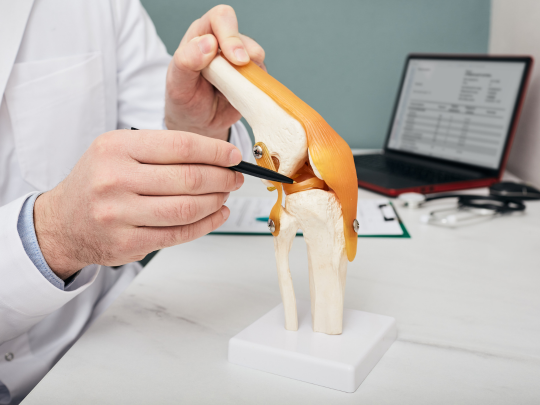
Meniscus Repair: Restoring Knee Health and Function
If you’ve been enduring knee pain or recently diagnosed with a meniscus injury, you are likely exploring the best treatment options to regain mobility and a pain-free life. Meniscus repair is a surgical procedure designed to restore knee health and function by addressing damage to the meniscus, a vital component of the knee joint.
This article will outline the intricacies of meniscus injuries, the surgical techniques used to repair them, the recovery process, and what you can expect as outcomes.
We aim to give you the information you need to make informed decisions about your knee health.
Understanding Meniscus Injuries
The meniscus is a C-shaped piece of cartilage in the knee that acts as a shock absorber between the thigh bone (femur) and shin bone (tibia), protecting the vital articular cartilage that lines the knee joint surfaces. It is essential for evenly distributing weight, lubricating the joint, and enabling smooth movement. The meniscus also acts to stabilise the knee with rotational movements.
Meniscus injuries often occur due to trauma or degeneration. Common causes include sudden twisting motions, accidents during sports, or the natural wear and tear that comes with age. (These are 2 different species—traumatic tears are associated with a discrete traumatic event, and atraumatic tears often don’t have a single inciting event and come on suddenly. Atraumatic tears can even happen while turning over in bed.)
Tears in the meniscus can vary in type, such as longitudinal, bucket-handle, or radial tears. Tears can also occur at the anchor points at the front and back of the meniscus, called root tears. Symptoms typically include knee pain, swelling, limited range of motion, and a sensation of instability or locking in the joint. A precise diagnosis is crucial and often involves a comprehensive physical examination and imaging tests like MRI scans.
Surgical Techniques for Meniscus Repair
Meniscus repair is generally performed using arthroscopic surgery, a minimally invasive method that deploys a small camera and surgical instruments to visualise and treat the damaged area. The primary objective is to preserve as much of the meniscus as possible.
Several techniques are used in surgery. Meniscus suturing involves stitching the torn edges together, allowing them to heal naturally. Reattachment may be necessary in cases of complex detachment. Alternatively, if the damage is irreparable or the meniscus tissue of poor healing potential, a partial meniscectomy is carried out to remove the damaged area while preserving the healthy tissue. The surgical approach depends on the tear’s size, location, and severity, all of which your surgeon will thoroughly evaluate.
Preparing for Meniscus Repair Surgery
Successful surgery begins with thorough preparation. Your surgeon will conduct a preoperative evaluation, typically including a detailed medical history, imaging tests, and a discussion of your expectations and concerns. Communicating openly with your surgeon is essential to ensure you understand the procedure and recovery process.
Preparing for surgery also involves optimising your home environment for postoperative recovery. For example, you may need to arrange for crutches or a knee brace, place frequently used items within easy reach, and prepare meals in advance to reduce the physical strain during the initial healing phase.
The Meniscus Repair Procedure
During the surgery, you will likely be under local or general anaesthesia. A small incision is made to insert the arthroscope, which provides a clear view of the knee joint. Using tiny instruments, the surgeon will repair the meniscus with sutures or fixation devices. This minimally invasive approach reduces damage to the surrounding tissues and recovery time and promotes a quicker return to daily activities. Depending on the complexity of your injury, the procedure typically takes about an hour or two.
Surgeons may also take specific measures during the procedure to minimise postoperative swelling and pain, such as local anesthetic infiltration, anti-inflammatory medications, and meticulous surgical techniques and medications to reduce bleeding in the knee.
Recovery and Rehabilitation
Recovery is a critical phase of meniscus repair. Postoperative care involves managing pain with medications, using ice packs to reduce swelling, and keeping the knee elevated. Depending on the technique used, your surgeon may recommend a brace or crutches to protect the repaired meniscus during its initial healing phase. Blood thinning medications are often required to reduce the risk of blood clots.
Physical therapy begins shortly after surgery and plays a crucial role in regaining strength, flexibility, and range of motion. A physiotherapist will guide you through tailored exercises, gradually progressing to more challenging activities. Light activities may resume within a few weeks for some, while full recovery, including returning to sports, can take six months or longer. Consistency and patience during rehabilitation can profoundly impact your long-term results.
Potential Risks and Complications
While meniscus repair is generally a safe procedure, as with any surgery, some risks are associated. These may include infection, issues with wound healing, blood clots, or stiffness in the knee joint. Some people find the knots or suture anchors irritating
Occasionally, the repaired meniscus may not heal as expected, necessitating further treatment. Your surgeon will discuss these risks with you beforehand and take proactive steps to minimise complications.
Expected Outcomes and Prognosis
The success of meniscus repair depends on several factors, including the type and location of the tear, the surgical technique used, and your adherence to the rehabilitation plan. Most patients experience significant improvement in mobility and a reduction in pain levels.
Achieving long-term benefits, such as maintaining joint health and resuming sports or active lifestyles, is a realistic expectation for many individuals with a properly repaired meniscus.
We hope that this guide has answered your questions about meniscus repair and given you confidence in your path to recovery. Every case is unique, and consulting with an experienced orthopaedic surgeon is vital for tailored advice.
By staying informed, actively participating in your recovery process, and following professional recommendations, you can look forward to regaining mobility and enjoying an active, healthy lifestyle.
Here’s to a pain-free, revitalised knee.
Frequently Asked Questions
Can all meniscus tears be repaired?
No, certain tears, especially degenerative ones, may not be repairable. Your surgeon will help determine the best approach.
How long does the surgery take?
Typically, 1-2 hours.
Will I need crutches or a knee brace post-surgery?
Most patients need these to protect the knee during the initial healing phase.
When can I resume sports activities?
Around 4-6 months, depending on your recovery progress.
How can I prevent future meniscus injuries?
Strengthening the muscles around your knee and warming up before activities can reduce the risk.
